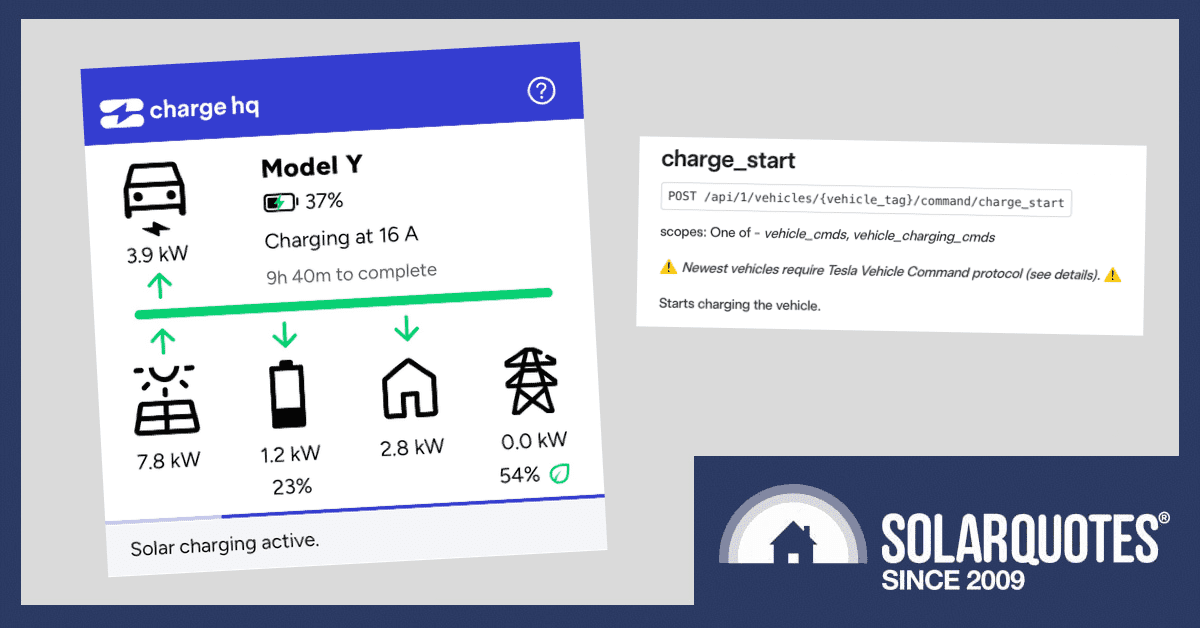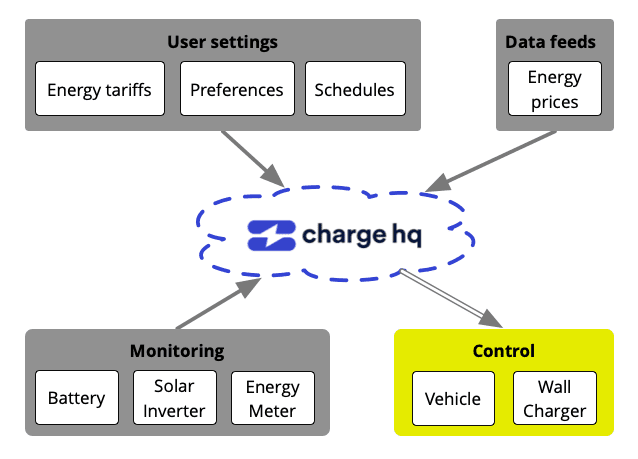
Charge HQ co-founder Andrew Rogers recently said the company faces an uncertain future. This post will explain what’s happening, why it matters, and suggest some possible ways forward.
What is Charge HQ
Charge HQ is a popular Australian app that helps you manage your EV, EV charger, home battery, and solar system using the cloud. It gives you more control over how you charge your EV, such as:
- Charging with excess solar power
- Charging mostly with solar, then topping up with a cheap overnight tariff
- Charging based on timers, excess solar, electricity price, or the percentage of renewables in the grid
This is especially useful if you have different brands in your home energy system or EV fleet that would otherwise struggle to work together for optimal EV charging.
It’s a great solution, particularly popular with Tesla owners, as Teslas can only smart charge without an app like Charge HQ if you buy the full Tesla eco-system: car, charger, and Powerwall.

What’s Causing The Uncertainty?
Let’s unpack how this situation came about.
2021: Charge HQ founded using free Tesla API
When founded in 2021, Charge HQ was a free service that controlled non-Tesla EVs using the free, open OCPP protocol and controlled Tesla EVs using the unofficial, free Tesla API.
Teslas are unique in that their charging is controlled by talking to the car (not the wall charger) via a proprietary Tesla API.
Mid 2023: Charge HQ starts charging a subscription
In Mid 2023, Charge HQ started charging new customers a subscription to try and cover the costs of operating the company. At the time, existing Charge HQ customers were grandfathered into free, full-featured plans.
October 2023: Tesla announces end of Free API access
In October 2023, Tesla threw a spanner in the works for companies relying on their unofficial free API, saying it would be shut down by January 2024. Tesla would offer an official third-party API instead with different rate limits and eventually charge for usage.
At the same time, Australian electricity retailers such as AGL, Origin, Ovo, Powershop, Red Energy and others have been trialling electricity offers specifically targeting EV owners.
Electricity retailing innovator Amber has gone one step further. They suggest customers use Charge HQ but quite openly have also been working on developing their own in-house Amber for EVs technology to optimise EV charging.
An Uncertain Future for Charge HQ
Rogers was quite honest about the situation in various comments he made recently on the Charge HQ forums (key excerpt quotes are below):
“At the end of June 2024, all users on the early adopter plan will automatically switch to the free plan (which does not include solar charging)”.
“When the Tesla API pricing is introduced we expect that the free plan will need to be suspended for all users and that the solar plan will see a price increase or a reduction in functionality, or both“.
“Right now there’s a very small number of users with OCPP chargers so it’s a matter of believing we can grow this to make it viable if we don’t find a solution that works for Tesla users.”
“We are continuing to look for ways to allow us to keep the service running as a viable business. If we reach a point where we can’t see a way forward we will publish guides with suggested alternatives for optimising your EV charging”.
The Charge HQ Solar Plan mentioned currently costs $7/month ($84/year), and it will likely rise further.
That compares to the average saving per Charge HQ user of $125-$140 a year.
Customers Jumping Ship?
I asked several members of the Australian EV-owning community who have used Charge HQ what they would do. A selection of their answers gives a good snapshot of sentiment at present and shows many have no loyalty to the service:
Alex – “I installed Charge HQ to control my OCPP ZJBeny EVSE pretty much as soon as I had it installed in October 2023. I used the trial to get it all working then moved to the $7/month subscription after one month and still subscribe”.
“They have a difficult business model to sustain as scheduled charging is usually easily done without need of a paid subscription, while the savings with use of excess solar PV are small when you can buy power for free or with low cost tariff windows and are often not outweighed by the subscription cost”.
“I recently moved to a new EV electricity plan with 2 hours of free electricity 12-2PM every day, so it uses that, then in afternoons captures any excess solar PV (very low feed in credit of 1.4c/kWh)”.
Robert – “Yes, still using it, started when we got the car in March 22. Even though OVO plan has made us use the solar function less, we’ll be using it more now that we will move back to soaking up more solar during the day. Charge HQ has been an extremely convenient plug and play solution.”
Vincent – “I’m with OVO, and paying for Charge HQ . I love all the features and flexibility that it provides. It’ll cost me more money and time to do this myself using evcc / home assistant”.
Lisa – “As an early adopter of Charge HQ I stopped using it as the new cost far exceeds what I’d save in charging costs.”
Julian – “Quit Charge HQ. Monthly fee was too high and didn’t make economic sense. I just schedule charge 0900-1530 based on best guess solar curves.”
Luke – “I’ve recently switched to the Amber Electric beta EV solution as it’s better designed to deal with variable pricing.”
Neil – “I was using Charge HQ but the demise of the early adopter plan coincided with me getting on the Amber EV alpha option which is working very well for me.”
Gary – “I was using it, but Amber Electric offered for me to join the EV Alpha program just before the start of the month. Alpha is working well, and I can’t wait for beta.”
What are Charge HQ’s Options Going Forward?
With about 90% of their customer base using Charge HQ to smart charge Teslas, Charge HQ is in a pickle. As far as we can see, they have the following options:
- Charge enough to be profitable with Tesla’s new API charges, and hope enough Tesla owners will pay.
- Stop offering solar smart charging via the Tesla car and target EV owners who have invested in an OCPP-compatible charger. Although this is currently only 10% of their customer base, states and territories are likely to follow SA’s lead in mandating OCPP on all new home chargers, so this should be a growing market.
- Wait until the Tesla Wall Connector gets OCPP compatibility1, and use the charger to smart charge Teslas instead of the car.
- Find a business model that generates revenue without a subscription. For example, suggest EV charging plans based on the charging profile and take a finders fee from energy retailers, sponsorship, advertising, or lead generation.
- Get bought out for their underlying technology so the founders can make some financial return from all their efforts in helping early adopter Australian EV owners recharge their cars cheaply.
In the comments, let me know if you think we’ve missed any options for keeping this great Aussie App going.
Footnotes
- The SA approved charger list shows the Tesla wall connector as OCPP compatible. Currently, it does not have OCPP, so we can only assume it is coming to the Wall Connector soon so it can continue to be installed on a 32A circuit in South Australia. ↩

 RSS - Posts
RSS - Posts



I’ve got a mix of Hyundai pv panels, Fronius inverter, Tesla Powerwall and a Hyundai EV. My Zappi charger manages charging by tracking solar output with no issues, despite not being OCPP compatible and I don’t have to pay a monthly sub. Happy days.
If nothing else i could see a poor mans control system for charging with a remote controlled switch/breaker between the solar charger and the mains/inverter connection.
Though thats really only to stop it charging when you don’t want it too.
There really does need to be some universal local API standard implemented though. essentially nothing is cross compatible half the time unless its the same brand. and half of everything on the market doesn’t have local API access or makes you go through hoops to activate a local API connection instead of the cloud one.
While it’s much more complicated to setup, it’s possible to replicate ChargeHQs functionality for free in Home Assistant and send commands to Tesla vehicles over local Bluetooth.
I was an early adopter of Charge Hq and was/still am impressed with what the product offered. When Tesla added charge on solar I stayed with Charge HQ because it allowed you to prioritise house battery or car with variable limits and offered the best of all worlds.
But I was getting it for free, and since we added the second house battery it did not make economic sense to move to the albeit only $7 month.
We trialed using Tesla Charge on solar over Charge HQ after the second battery install and this works for us just as well. If it did not we would have happily stumped up the monthly subscription for the convenience. Always liked the App and have always recommended it others.
I honestly hope they find a sustainable commercial niche, as they have a good product that fostered a lot of good will in the EV community.
If Solaredge release their new EV Charger here that will make it far easier I feel. The ability to charge with High Voltage DC direct from your DC string and they already have modes for preferencially directing power. It’s been “coming soon” for a long time though..
This article pretty much nails it and I think the last two bullet points are the only realistic options. The underlying problem is this type of business cannot compete with cheap/free energy windows from retailers.
In my case, I wrote my own solution in Home Assistant late 2022 but have since abandoned it. My logic: we get free power from 11am-2pm and 8c/kWh 12am-6am. I simply schedule the charging between those hours and do not need any solar soaking smarts. I suspect I’m not the only one doing this.
If, OTOH, energy plans were modified to remove free charging windows (offset by, say, a much higher solar FIT) then solutions like ChargeHQ would make economic sense again.
Thinking laterally, ChargeHQ is just a limited example of where we are heading with energy loads. In the face of a more complex and expensive energy supply, homes will need to get smarter in scheduling all loads (not just EV charging). Perhaps that is where this type of technology needs to head?
Which power company do you use for free and cheap power?
Hi Ef,
OVO and Amber come to mind but there may be others
Yes, I’m with OVO Energy in Queensland
I’ve been on ChargeHQ for about 12 months. I have a ZJ Beny with OCPP and use the PushAPI because there is no off the shelf integration for my systems.
About 4 months ago, I switched to OVO. I take advantage of their free power between 11:00-14:00 and and occasionally I use the 8c charging between 00:00-06:00. This also includes charging the house battery for free, 467 kwh free power last month, take that solar duck!
Because of TOU tariffs, the economic case for ChargeHQ is decreased. I can simply schedule a a charge and not worry about ChargeHQ. But I like to get to most out of my solar so I still use it to prioritise charging the car over the battery outside of the free hours. I’ll stick with them, but I understand why people would want to leave.
I hope they survive.
I was an early adopter and I trialled ChargeHQ but unfortunately it came after I’d already paid for a Zappi system. I was very impressed with ChargeHQ’s app and how well it worked with Teslas but of course I didn’t really need it as I had the Zappi which basically mirrors ChargeHQ’s functionality. And I had no way of making it work with my Atto 3.
I think there are a couple of other stumbling blocks apart from the major ones mentioned in the app – one would be Apple’s control of the app store which affects their ability to offer a more reasonable price (not that I think their price is unreasonable it’s just they have to pay Apple their cut). Another would be the lack of cooperation from the automobile manufacturers – Tesla at least had an API you could work with. I’m assuming that is why they didn’t offer it for other brands of EVs, just OCPP compatibility. And the big problem with that is a lot of consumers don’t even know what OCPP is.
I think if they could have promoted this product more widely than Australia then the sheer size of the potential market might have helped? I hope they survive – good luck!
I’ve had a Fronius smart charger and a Fronius inverter with a Powerwall for the last 8 months but never have tried to put the smart charging to use, instead manually plugging and unplugging the Polestar when the sun shines!
David, your system almost mirrors mine except that I use Enphase microinverters. All the rest the same include Hyundai panels and EV. Sadly, you’re not home free yet. I don’t know how you use your PowerWall but the API changes potentially affect all PowerWall users as they dicate how all apps that control the PowerWall work, including things like HA integrations, NetBlue, etc. Tesla is progressively screwing over battery owners – we used to be able to locally control the battery, then they took that away with a could-only “update”, now they’re going to start making us pay for the Cloud-Only API. PowerWall 3 units have zero local interface, not even monitoring, it’s 100% via-the-internet only. People like Amber pay for a different VPN API, and I’m hoping someone will open up access to that. but frankly, anyone thinking about PowerWalls – just no, don’t do it. What happens when Musk has a brain fart (another?) and the company goes down the bunghole .. and their web APIs are gone. One big minimal-function battery.
Could chargeHQ make money with demand management? Eg being able to reduce or stop EV charging at times of grid instability, which can happen even during the cheap or free periods offered by the EV plans. As long as the car got to its target overnight or was stopped only rarely during the free period in the day, I would be willing to give them this control.
On ovo I’ve currently got an 8 cent FIT, 8 cents from midnight to 6 am and free between 11 am and 2 pm… Tesla have also just improved their charge scheduling allowing setting the start and stop times and creating multiple charge periods over 24 hours and even the ability to have a different schedule for each day of the week. The only thing missing from chargeHQ’s schedule is the ability to set different limits for each period… but $7 per month is a lot. I don’t see the ovo plan staying as good and I think the financial utility of chargeHQ is likely to improve, particularly if they can secure some alternative sources of income and lower the price to end users.
Just to clarify, the only thing missing in Tesla’s scheduling implementation compared to chargeHQ is the ability to set different charge limits.
It would be interesting to know what those using Amber’s new solution are paying on average for EV charging. Does it work out better or worse than The EV plans?